HUMMER H3 2007 Owners Manual
Manufacturer: HUMMER, Model Year: 2007, Model line: H3, Model: HUMMER H3 2007Pages: 480, PDF Size: 2.73 MB
Page 301 of 480

Hitches
It’s important to have the correct hitch equipment.
Crosswinds, large trucks going by and rough
roads are a few reasons why you’ll need the
right hitch.
Weight-Distributing Hitches and Weight
Carrying Hitches
When using a weight-distributing hitch, the hitch
must be adjusted so that the distance (A) remains
the same both before and after coupling the
trailer to the tow vehicle.
Trailering may also be limited by the vehicle’s
ability to carry tongue weight. Tongue weight
cannot cause the vehicle to exceed the
GVWR (Gross Vehicle Weight Rating) or the
RGAWR (Rear Gross Axle Weight Rating).
The effect of additional weight may reduce your
trailering capacity more than the total of the
additional weight.
(A) Body-to-Ground Distance (B) Front of Vehicle
301
Page 302 of 480

Consider the following example:
A vehicle model base weight is 5,500 lbs
(2 495 kg); 2,800 lbs (1 270 kg) at the front
axle and 2,700 lbs (1 225 kg) at the rear axle.
It has a GVWR of 7,200 lbs (3 266 kg), a
RGAWR of 4,000 lbs (1 814 kg) and a GCWR
(Gross Combination Weight Rating) of 14,000 lbs
(6 350 kg). The trailer rating should be:
You can expect tongue weight to be at least
10 percent of trailer weight (850 lbs (386 kg)) and
because the weight is applied well behind the
rear axle, the effect on the rear axle will be greater
than just the weight itself, as much as 1.5 times
as much. The weight at the rear axle could
be 850 lbs (386 kg) X 1.5 = 1,275 lbs (578 kg).
Since the rear axle already weighs 2,700 lbs
(1 225 kg), adding 1,275 lbs (578 kg) brings the
total to 3,975 lbs (1 803 kg). This is very close to,
but within the limit for RGAWR as well. The
vehicle is set to trailer up to 8,500 lbs (3 856 kg).But let’s say your speci�c vehicle is equipped with
some of the latest options and you have a front
seat passenger and two rear seat passengers with
some luggage and gear in the vehicle as well.
You may add 300 lbs (136 kg) to the front
axle weight and 400 lbs (181 kg) to the rear axle
weight. Your vehicle now weighs:
Weight is still below 7,200 lbs (3 266 kg) and you
may think that you should subtract 700 additional
pounds (318 kg) from your trailering capacity
to stay within GCWR limits. Your maximum
trailer would only be 7,800 lbs (3 538 kg).
You may go further and think you must limit
tongue weight to less than 1,000 lbs (454 kg)
to avoid exceeding GVWR. But, you must
still consider the effect on the rear axle.
Because your rear axle now weighs 3,100 lbs
(1 406 kg), you can only put 900 lbs (408 kg)
on the rear axle without exceeding RGAWR.
302
Page 303 of 480
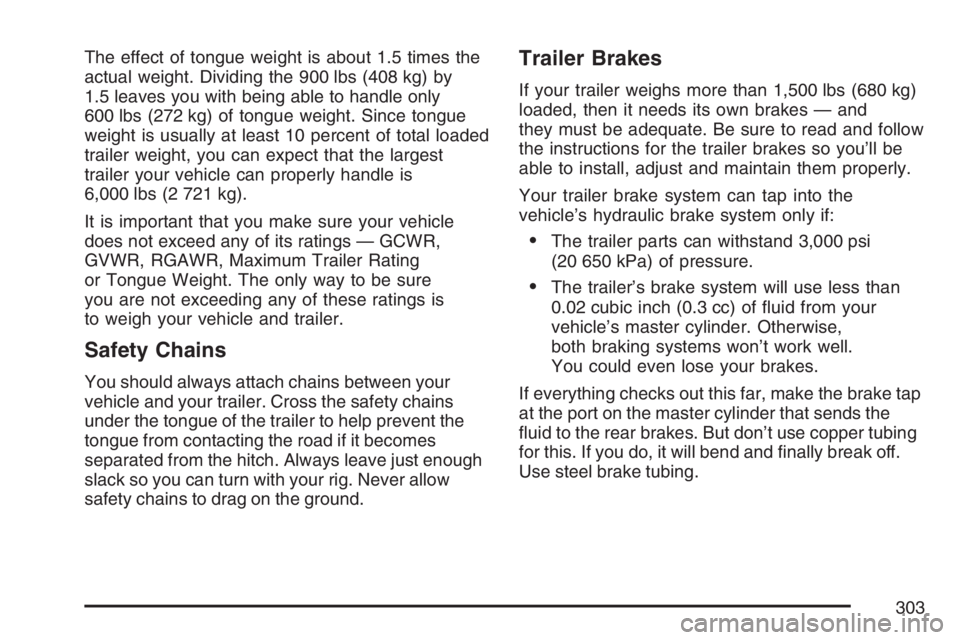
The effect of tongue weight is about 1.5 times the
actual weight. Dividing the 900 lbs (408 kg) by
1.5 leaves you with being able to handle only
600 lbs (272 kg) of tongue weight. Since tongue
weight is usually at least 10 percent of total loaded
trailer weight, you can expect that the largest
trailer your vehicle can properly handle is
6,000 lbs (2 721 kg).
It is important that you make sure your vehicle
does not exceed any of its ratings — GCWR,
GVWR, RGAWR, Maximum Trailer Rating
or Tongue Weight. The only way to be sure
you are not exceeding any of these ratings is
to weigh your vehicle and trailer.
Safety Chains
You should always attach chains between your
vehicle and your trailer. Cross the safety chains
under the tongue of the trailer to help prevent the
tongue from contacting the road if it becomes
separated from the hitch. Always leave just enough
slack so you can turn with your rig. Never allow
safety chains to drag on the ground.
Trailer Brakes
If your trailer weighs more than 1,500 lbs (680 kg)
loaded, then it needs its own brakes — and
they must be adequate. Be sure to read and follow
the instructions for the trailer brakes so you’ll be
able to install, adjust and maintain them properly.
Your trailer brake system can tap into the
vehicle’s hydraulic brake system only if:
The trailer parts can withstand 3,000 psi
(20 650 kPa) of pressure.
The trailer’s brake system will use less than
0.02 cubic inch (0.3 cc) of �uid from your
vehicle’s master cylinder. Otherwise,
both braking systems won’t work well.
You could even lose your brakes.
If everything checks out this far, make the brake tap
at the port on the master cylinder that sends the
�uid to the rear brakes. But don’t use copper tubing
for this. If you do, it will bend and �nally break off.
Use steel brake tubing.
303
Page 304 of 480
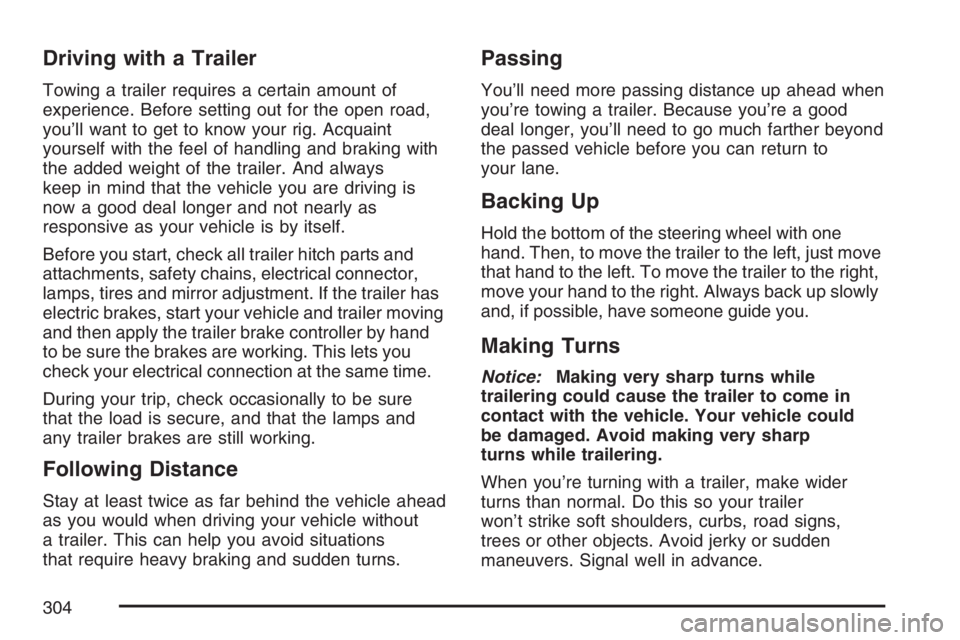
Driving with a Trailer
Towing a trailer requires a certain amount of
experience. Before setting out for the open road,
you’ll want to get to know your rig. Acquaint
yourself with the feel of handling and braking with
the added weight of the trailer. And always
keep in mind that the vehicle you are driving is
now a good deal longer and not nearly as
responsive as your vehicle is by itself.
Before you start, check all trailer hitch parts and
attachments, safety chains, electrical connector,
lamps, tires and mirror adjustment. If the trailer has
electric brakes, start your vehicle and trailer moving
and then apply the trailer brake controller by hand
to be sure the brakes are working. This lets you
check your electrical connection at the same time.
During your trip, check occasionally to be sure
that the load is secure, and that the lamps and
any trailer brakes are still working.
Following Distance
Stay at least twice as far behind the vehicle ahead
as you would when driving your vehicle without
a trailer. This can help you avoid situations
that require heavy braking and sudden turns.
Passing
You’ll need more passing distance up ahead when
you’re towing a trailer. Because you’re a good
deal longer, you’ll need to go much farther beyond
the passed vehicle before you can return to
your lane.
Backing Up
Hold the bottom of the steering wheel with one
hand. Then, to move the trailer to the left, just move
that hand to the left. To move the trailer to the right,
move your hand to the right. Always back up slowly
and, if possible, have someone guide you.
Making Turns
Notice:Making very sharp turns while
trailering could cause the trailer to come in
contact with the vehicle. Your vehicle could
be damaged. Avoid making very sharp
turns while trailering.
When you’re turning with a trailer, make wider
turns than normal. Do this so your trailer
won’t strike soft shoulders, curbs, road signs,
trees or other objects. Avoid jerky or sudden
maneuvers. Signal well in advance.
304
Page 305 of 480
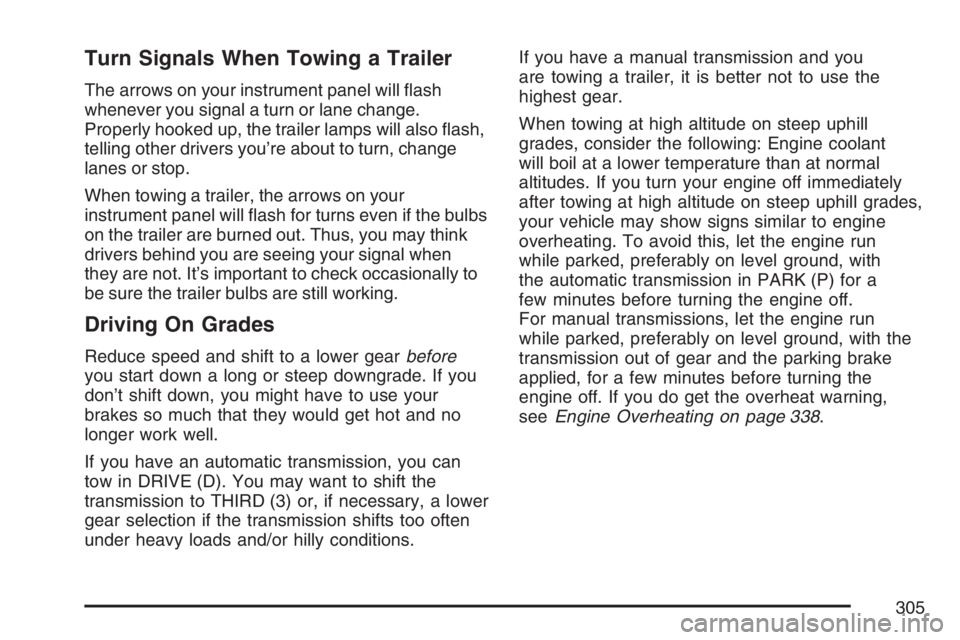
Turn Signals When Towing a Trailer
The arrows on your instrument panel will �ash
whenever you signal a turn or lane change.
Properly hooked up, the trailer lamps will also �ash,
telling other drivers you’re about to turn, change
lanes or stop.
When towing a trailer, the arrows on your
instrument panel will �ash for turns even if the bulbs
on the trailer are burned out. Thus, you may think
drivers behind you are seeing your signal when
they are not. It’s important to check occasionally to
be sure the trailer bulbs are still working.
Driving On Grades
Reduce speed and shift to a lower gearbefore
you start down a long or steep downgrade. If you
don’t shift down, you might have to use your
brakes so much that they would get hot and no
longer work well.
If you have an automatic transmission, you can
tow in DRIVE (D). You may want to shift the
transmission to THIRD (3) or, if necessary, a lower
gear selection if the transmission shifts too often
under heavy loads and/or hilly conditions.If you have a manual transmission and you
are towing a trailer, it is better not to use the
highest gear.
When towing at high altitude on steep uphill
grades, consider the following: Engine coolant
will boil at a lower temperature than at normal
altitudes. If you turn your engine off immediately
after towing at high altitude on steep uphill grades,
your vehicle may show signs similar to engine
overheating. To avoid this, let the engine run
while parked, preferably on level ground, with
the automatic transmission in PARK (P) for a
few minutes before turning the engine off.
For manual transmissions, let the engine run
while parked, preferably on level ground, with the
transmission out of gear and the parking brake
applied, for a few minutes before turning the
engine off. If you do get the overheat warning,
seeEngine Overheating on page 338.
305
Page 306 of 480
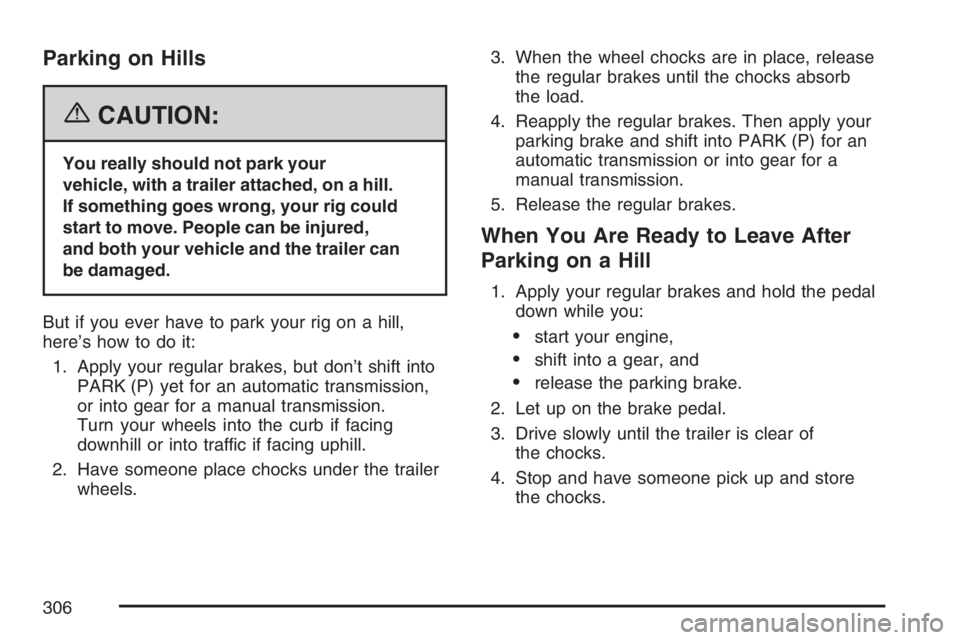
Parking on Hills
{CAUTION:
You really should not park your
vehicle, with a trailer attached, on a hill.
If something goes wrong, your rig could
start to move. People can be injured,
and both your vehicle and the trailer can
be damaged.
But if you ever have to park your rig on a hill,
here’s how to do it:
1. Apply your regular brakes, but don’t shift into
PARK (P) yet for an automatic transmission,
or into gear for a manual transmission.
Turn your wheels into the curb if facing
downhill or into traffic if facing uphill.
2. Have someone place chocks under the trailer
wheels.3. When the wheel chocks are in place, release
the regular brakes until the chocks absorb
the load.
4. Reapply the regular brakes. Then apply your
parking brake and shift into PARK (P) for an
automatic transmission or into gear for a
manual transmission.
5. Release the regular brakes.
When You Are Ready to Leave After
Parking on a Hill
1. Apply your regular brakes and hold the pedal
down while you:
start your engine,
shift into a gear, and
release the parking brake.
2. Let up on the brake pedal.
3. Drive slowly until the trailer is clear of
the chocks.
4. Stop and have someone pick up and store
the chocks.
306
Page 307 of 480

Maintenance When Trailer Towing
Your vehicle will need service more often when
you’re pulling a trailer. See the Maintenance
Schedule for more on this. Things that are
especially important in trailer operation are
automatic transmission �uid, engine oil, axle
lubricant, belts, cooling system and brake
system. Each of these is covered in this manual,
and the Index will help you �nd them quickly.
If you’re trailering, it’s a good idea to review
these sections before you start your trip.
Check periodically to see that all hitch nuts
and bolts are tight.
Trailer Wiring Harness
Light-Duty Trailer Wiring Package
If your vehicle is not equipped with a trailer
towing package, the chassis harness will
contain the following blunt cut circuits:
Yellow: Left Stop/Turn Signal
Dark Green: Right Stop/Turn Signal
White: Ground
Brown: Tail Lamps
If you want to add on a trailer tow, it should be
installed by your dealer or a quali�ed service
center. Also, seeAdd-On Electrical Equipment
on page 416for more information.
307
Page 308 of 480
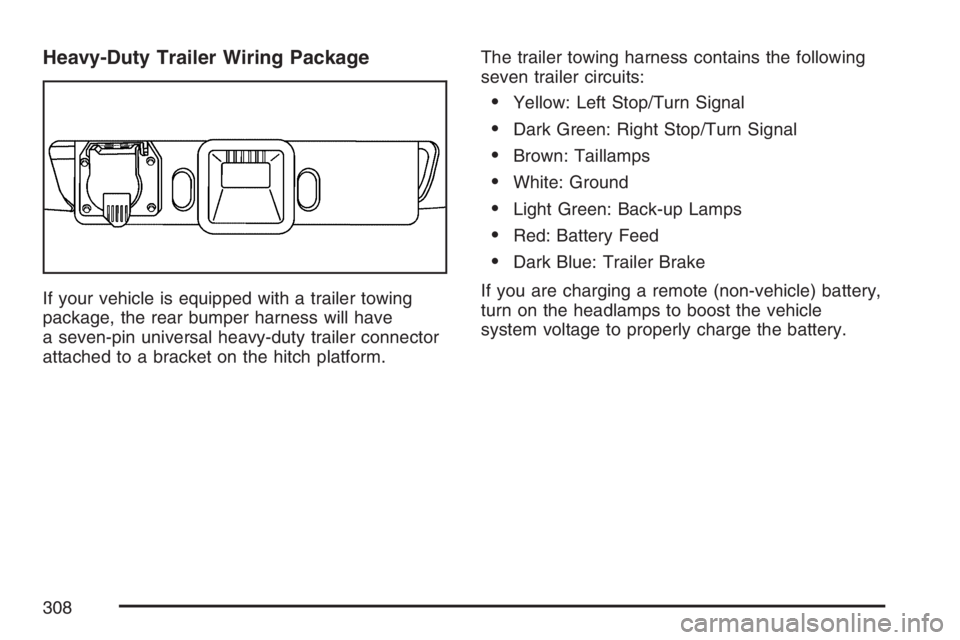
Heavy-Duty Trailer Wiring Package
If your vehicle is equipped with a trailer towing
package, the rear bumper harness will have
a seven-pin universal heavy-duty trailer connector
attached to a bracket on the hitch platform.The trailer towing harness contains the following
seven trailer circuits:
Yellow: Left Stop/Turn Signal
Dark Green: Right Stop/Turn Signal
Brown: Taillamps
White: Ground
Light Green: Back-up Lamps
Red: Battery Feed
Dark Blue: Trailer Brake
If you are charging a remote (non-vehicle) battery,
turn on the headlamps to boost the vehicle
system voltage to properly charge the battery.
308
Page 309 of 480
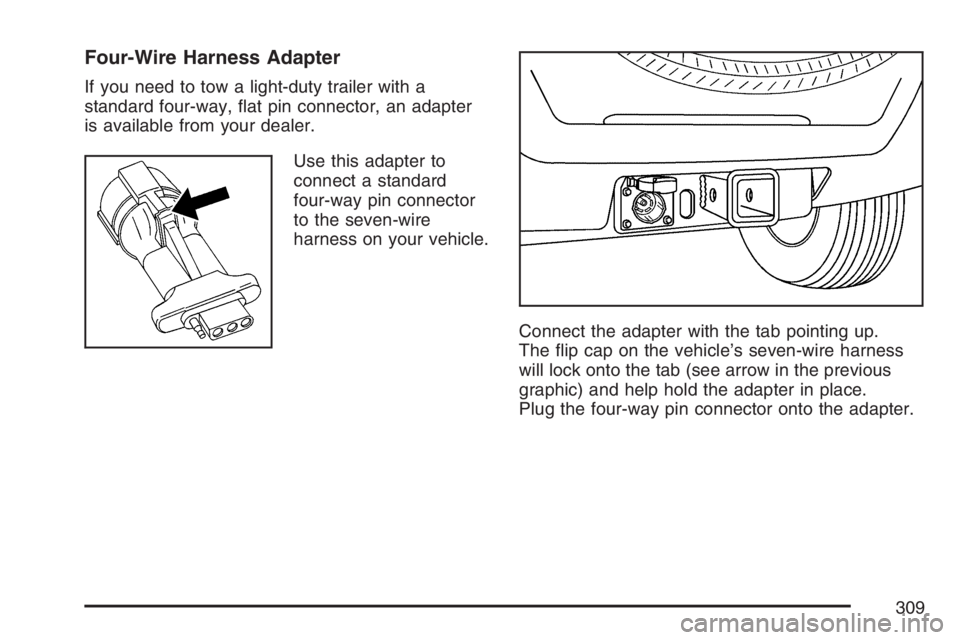
Four-Wire Harness Adapter
If you need to tow a light-duty trailer with a
standard four-way, �at pin connector, an adapter
is available from your dealer.
Use this adapter to
connect a standard
four-way pin connector
to the seven-wire
harness on your vehicle.
Connect the adapter with the tab pointing up.
The �ip cap on the vehicle’s seven-wire harness
will lock onto the tab (see arrow in the previous
graphic) and help hold the adapter in place.
Plug the four-way pin connector onto the adapter.
309
Page 310 of 480
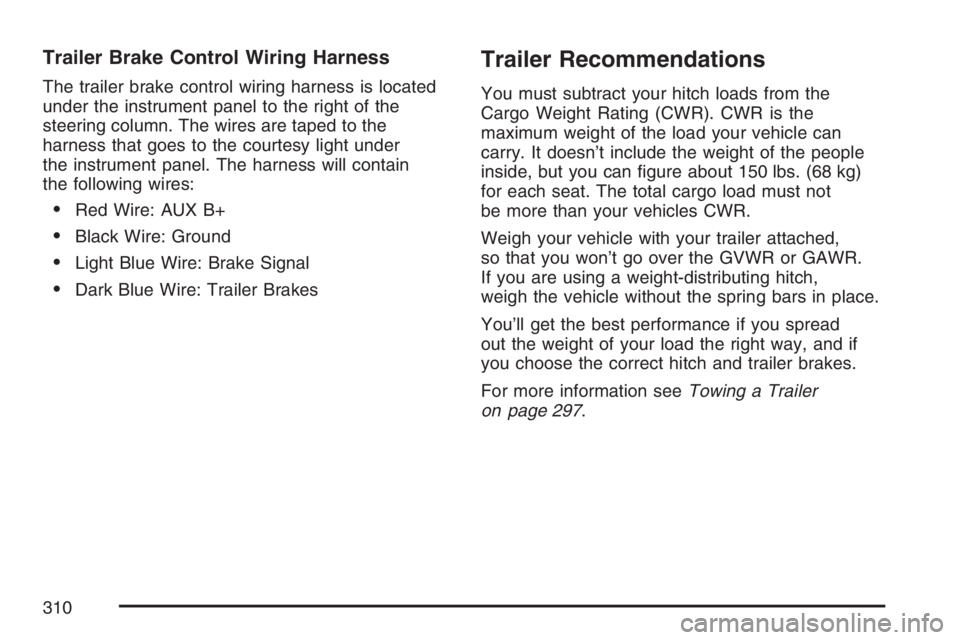
Trailer Brake Control Wiring Harness
The trailer brake control wiring harness is located
under the instrument panel to the right of the
steering column. The wires are taped to the
harness that goes to the courtesy light under
the instrument panel. The harness will contain
the following wires:
Red Wire: AUX B+
Black Wire: Ground
Light Blue Wire: Brake Signal
Dark Blue Wire: Trailer Brakes
Trailer Recommendations
You must subtract your hitch loads from the
Cargo Weight Rating (CWR). CWR is the
maximum weight of the load your vehicle can
carry. It doesn’t include the weight of the people
inside, but you can �gure about 150 lbs. (68 kg)
for each seat. The total cargo load must not
be more than your vehicles CWR.
Weigh your vehicle with your trailer attached,
so that you won’t go over the GVWR or GAWR.
If you are using a weight-distributing hitch,
weigh the vehicle without the spring bars in place.
You’ll get the best performance if you spread
out the weight of your load the right way, and if
you choose the correct hitch and trailer brakes.
For more information seeTowing a Trailer
on page 297.
310